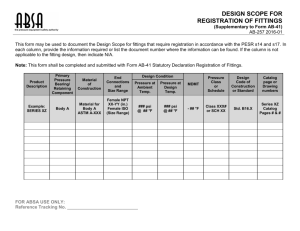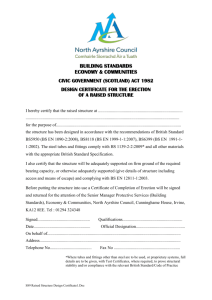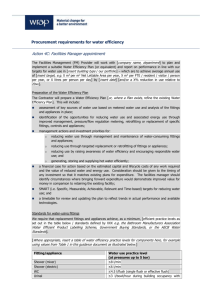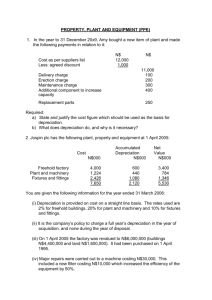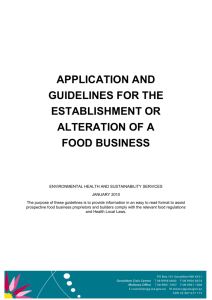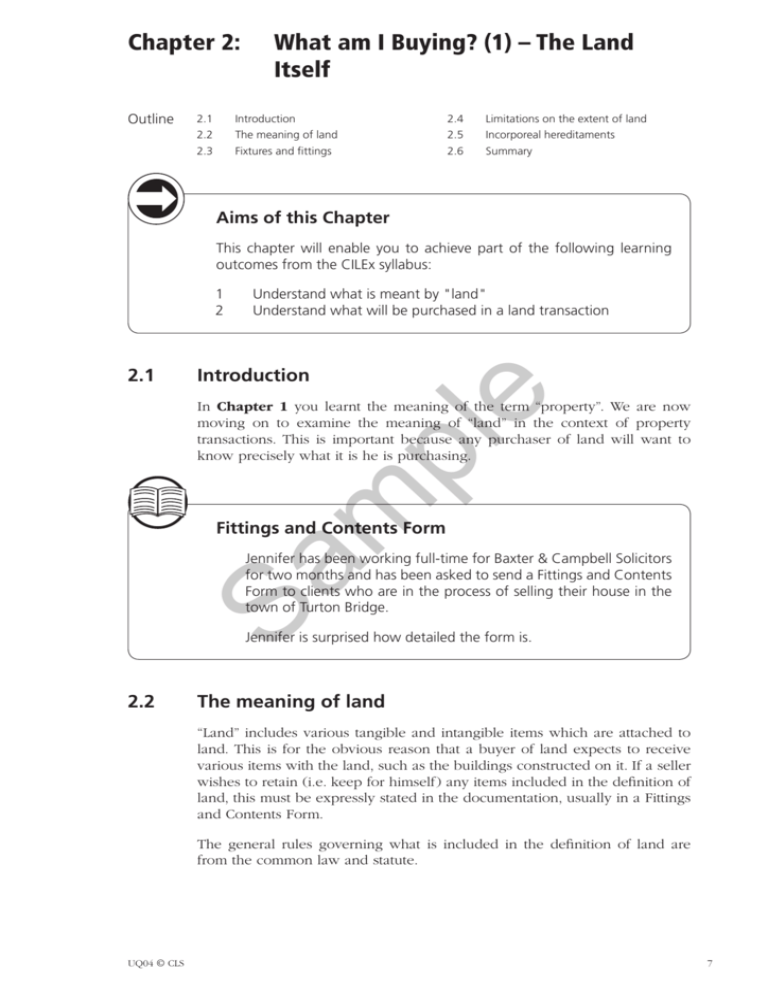
Chapter 2:
Outline
What am I Buying? (1) – The Land
Itself
2.1
Introduction
2.4
Limitations on the extent of land
2.2
The meaning of land
2.5
Incorporeal hereditaments
2.3
Fixtures and fittings
2.6
Summary
Aims of this Chapter
This chapter will enable you to achieve part of the following learning
outcomes from the CILEx syllabus:
1
2
Introduction
e
2.1
Understand what is meant by "land"
Understand what will be purchased in a land transaction
Sa
m
pl
In Chapter 1 you learnt the meaning of the term “property”. We are now
moving on to examine the meaning of “land” in the context of property
transactions. This is important because any purchaser of land will want to
know precisely what it is he is purchasing.
Fittings and Contents Form
Jennifer has been working full-time for Baxter & Campbell Solicitors
for two months and has been asked to send a Fittings and Contents
Form to clients who are in the process of selling their house in the
town of Turton Bridge.
Jennifer is surprised how detailed the form is.
2.2
The meaning of land
“Land” includes various tangible and intangible items which are attached to
land. This is for the obvious reason that a buyer of land expects to receive
various items with the land, such as the buildings constructed on it. If a seller
wishes to retain (i.e. keep for himself) any items included in the definition of
land, this must be expressly stated in the documentation, usually in a Fittings
and Contents Form.
The general rules governing what is included in the definition of land are
from the common law and statute.
UQ04 © CLS
7
2.2.1
What am I Buying? (1) – The Land Itself
2.2.1
The common law
There are two common law presumptions used to define the extent of land:
•
“he who owns the land owns everything extending to the heavens and
to the depths of the earth”; and
•
“whatever is attached to the ground becomes part of it”.
These presumptions are subject to various limitations: see 2.4.
2.2.2
Statutory definition
s205(1)(ix) LPA 1925 defines land as including: land of any tenure, any
mines or minerals whether or not held apart from the surface, buildings or
parts of buildings, whether the division is horizontal, vertical or made in any
other way . . . and other corporeal hereditaments . . . and other incorporeal
hereditaments.
“tenure” refers to the way the land is held (i.e. freehold or leasehold);
•
“corporeal hereditaments” means physical or tangible objects (e.g.
buildings);
•
“incorporeal hereditaments” are various intangible rights associated with
the land (e.g. the benefit of a right of way, or the benefit of a restrictive
covenant over the land of another).
pl
•
Sa
m
2.3
e
This statutory definition seems rather technical but is, in fact, fairly simple:
Fixtures and fittings
This is perhaps the most contentious issue of all. As noted above, anything
attached to the land becomes part of it. This includes buildings, trees and
plants. Such an attached object is known as a fixture, and when the land is
sold, leased or mortgaged, fixtures will also pass as a part of the transaction
unless the seller makes it clear that they are not intended to pass.
Other items that are not attached to the land are called fittings (sometimes
referred to as chattels) and will not pass automatically with the land; unless
agreed otherwise, the seller can remove fittings.
What will stay and what will go?
So, for Jennifer, the purpose of sending the Fittings and Contents
Form to the sellers in Turton Bridge is to clarify by express agreement
which fixtures will, and which will not, be sold with the land. This
form needs to be completed prior to exchanging contracts.
8
UQ04 © CLS
What am I Buying? (1) – The Land Itself
2.3.1
2.3.1
Why is a Fittings and Contents Form necessary?
The transfer or sale of land must be by deed (s52 LPA 1925), whereas the
transfer or sale of goods need not be by deed. The sale of goods and other
items will usually be valid even though the transaction is verbal or merely
written.
When land is sold, it is important to distinguish between items that are part
of the land (fixtures) and need to be transferred by deed, and those that are
not part of the land (fittings) and that do not need to be transferred by deed.
In order to avoid disputes over the unexpected removal of items such as
garden sheds, greenhouses or rotary washing lines, the fittings and contents
form should be completed.
e
What happens if the form is not completed? How do the courts distinguish
between fixtures and fittings?
pl
The need for a clear agreement
Sa
m
Jennifer remembers the excitement of moving into her new home
with Barry just after they married, only to find that the dimmer
switches had been removed from the living room and replaced with
cheap rocker switches, and a free-standing radiator was missing
from the workshop in the garage. Several rose bushes had been
removed from the garden as had a stone bird bath and a splendid
pot containing an azalea on the patio. Neither she nor Barry
remembered agreeing to these items being removed.
Now Jennifer is wondering whether they could have done something
about it. At the time, neither Jennifer nor Barry was particularly
concerned but perhaps they should or could have made a fuss.
2.3.2
Distinguishing between fixtures and fittings
The traditional approach of the courts has been to make use of two tests to
determine what amounts to a fixture. Neither of them is wholly satisfactory
and there is a large degree of overlap between the two. The courts frequently
use both tests together in order to reach a conclusion.
Degree of attachment
The first test looks at the degree of attachment of the object. If it is attached to
the land other than by its own weight, it is likely to be a fixture. In Holland v
Hodgson [1872], spinning looms were bolted to the floor of a mill. Being
attached other than by their own weight, the looms were held to be fixtures.
The degree of attachment test alone cannot, however, be conclusive. If it
were, then it could be argued that items such as pictures and curtains would
be part of the land.
UQ04 © CLS
9
2.3.2
What am I Buying? (1) – The Land Itself
Purpose of attachment
The courts also adopt a second test, which looks at the purpose of the
attachment: was the object attached for its own benefit – in which case it is
likely to remain a fitting or chattel – or was it attached for the benefit of the
land as a whole – in which case it may well be a fixture? In Leigh v Taylor
[1902], a tapestry that was nailed to the wall of the premises was held to be a
fitting. Normally, one hangs a picture, painting or tapestry to show the object
itself to its best advantage and not to benefit the house as a whole. There
may be exceptions, such as where the object is part of a general decorative
scheme. In D’Eyncourt v Gregory [1866], for instance, the court held that
marble statues of lions in a garden were fixtures as they were there to increase
the owner’s enjoyment of the land.
Permanence of the attachment
e
In addition to the above two tests, Botham v TSB Bank plc [1996] made
clear that the permanence of the attachment is also relevant. How long the
object is likely to be attached to the land is a quite separate issue from the
degree of attachment. Lampshades and curtains are unlikely to be considered
as fixtures, whereas light fittings and fitted shelves probably will be.
Sa
m
pl
It is difficult to determine whether some common household items are fixtures.
Carpets frequently cause problems: if sufficiently fitted, they are probably a
part of the land. On the facts in H E Dibble v Moore [1970], a greenhouse
was held not to be a fixture. In Elitestone Ltd v Morris [1997], the House
of Lords decided that a bungalow built on pillars was a fixture and in Chelsea
Yacht & Boat Co v Pope [2001], a houseboat moored by cables and ropes
with connection to mains water and power was held to be a fitting. It is
important to make quite clear, when selling land, what is being sold with the
land and what is not.
There were further developments in Taylor v Hamer [2002], where a large
country house was offered for sale. The dispute concerned a number of
flagstones, and whether they were to be included with the property. They
were there when the buyer inspected and made an offer for the property,
but were then removed prior to purchase. Since they were attached to the
land only by their own weight, the seller would have been entitled to remove
them, but he gave misleading replies when enquiries were made about them,
and disguised their removal with grassland. The buyer brought an action for
their return, and the Court of Appeal held that, for reasons of decency and
common sense, the buyer was entitled to receive what he had been shown on
inspection, and what he believed he would be receiving.
In Peel Land and Property (Ports No. 3) Ltd v TS Sheerness Steel Ltd
[2013] the court held that a number of items brought on to the site by the
original tenant were not attached to the land and so remained the tenant’s
chattels and were removable. These included cranes, transformers, a bar mill
weighing over 800 tonnes and a continuous casting machine weighing over
500 tonnes that were not attached to the land and had not become part of the
structure or fabric of the building. A furnace, which was integrated into the
building, was not considered removable.
10
UQ04 © CLS
© 2014 Copyright CILEx Law School Limited
All materials included in this CLS publication are copyright protected.
All rights reserved.
Any unauthorised reproduction or transmission of any part of this
publication, whether electronically or otherwise, will constitute an
infringement of copyright. No part of this publication may be lent, resold
or hired out for any purpose without the prior written permission of
CILEx Law School Ltd.
e
WARNING: Any person carrying out an unauthorised act in relation
to this copyright work may be liable to both criminal prosecution
and a civil claim for damages.
pl
This publication is intended only for the purpose of private study. Its
contents were believed to be correct at the time of publication or any
date stated in any preface, whichever is the earlier.
m
This publication does not constitute any form of legal advice to any person
or organisation.
Sa
CILEx Law School Ltd will not be liable for any loss or damage of any
description caused by the reliance of any person on any part of the
contents of this publication.
Published in 2014 by:
CILEx Law School Ltd
College House
Manor Drive
Kempston
Bedford
United Kingdom
MK42 7AB
British Library Cataloguing in Publication Data
A catalogue record for this manual is available from the British Library.
ISBN 978-1-84256-736-4

